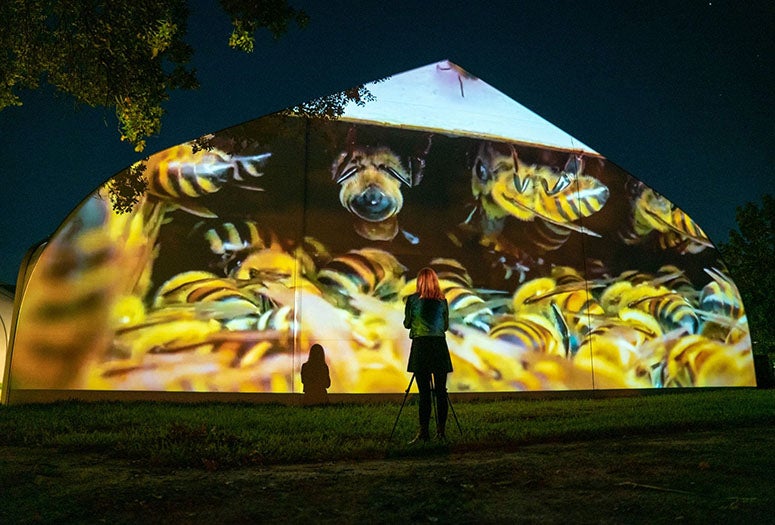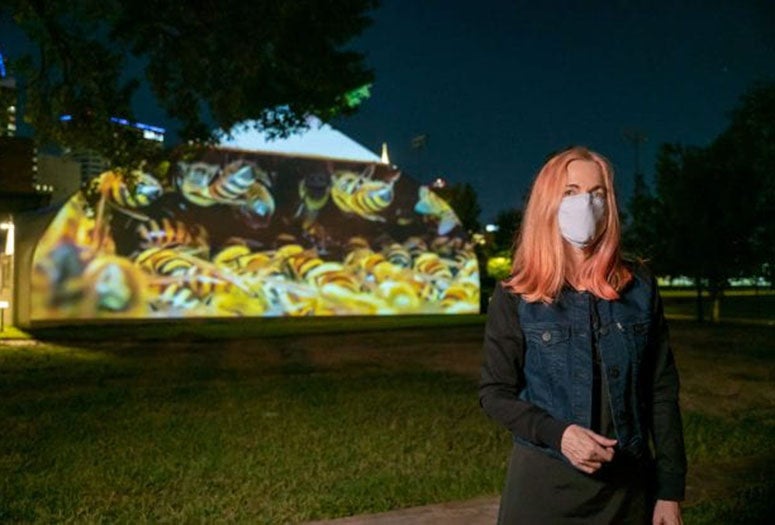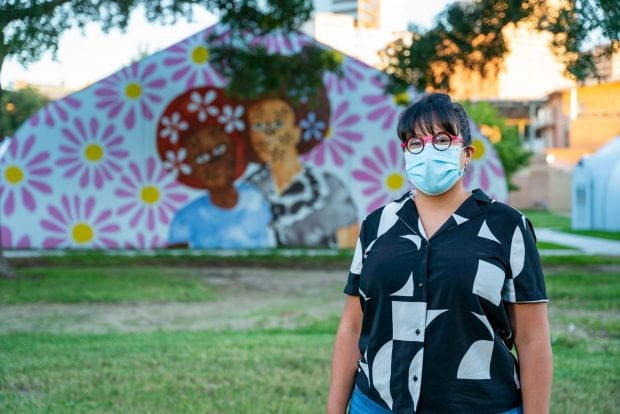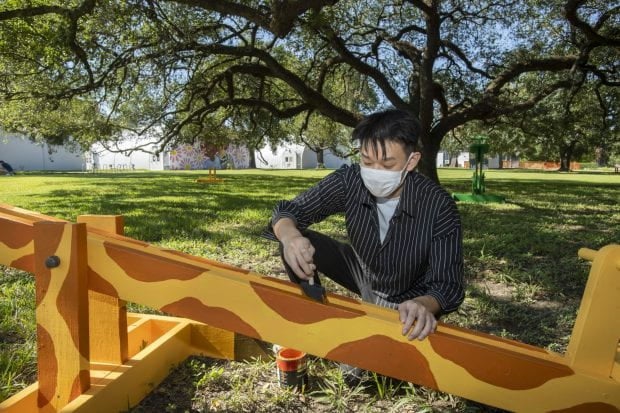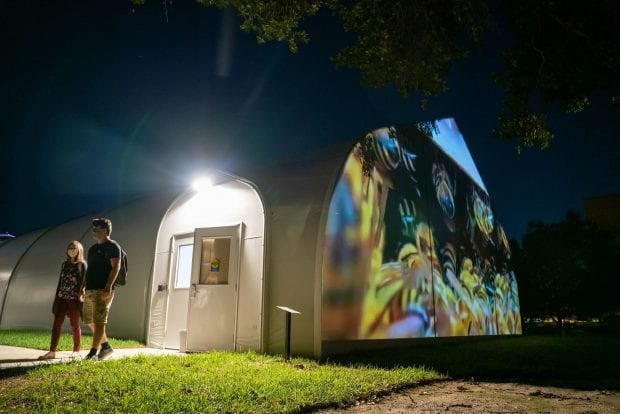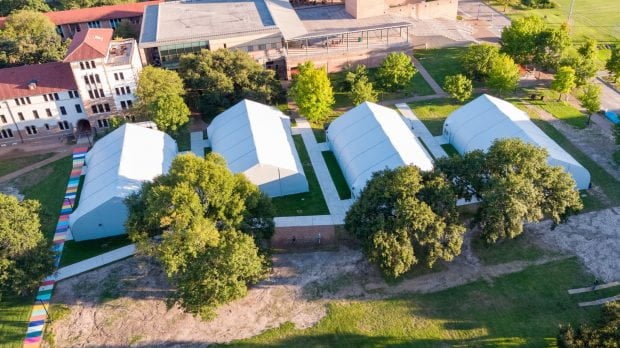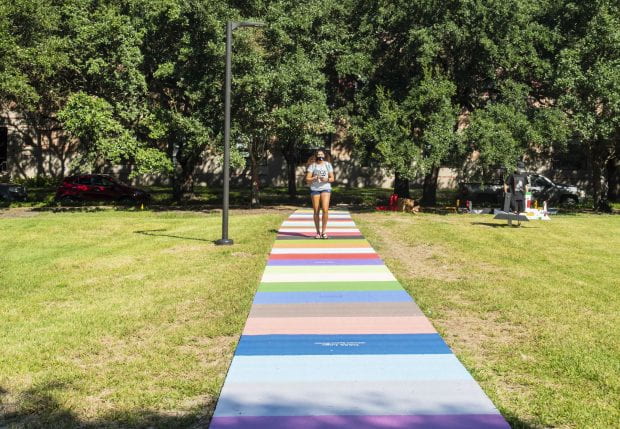HOUSTON – (Oct. 6, 2020) – The tent-like structures serving as temporary classroom spaces at Rice University during the pandemic could have been left as they were built: tall, steel-framed, silvery-white facilities tucked behind a row of live oak trees near Hanszen College at the corner of College Way and Alumni Drive.
Instead, the structures the university calls “provisional campus facilities” (PCFs) and the lawn outside them are now pulling double duty as vibrant public art installation spaces.
Two of the PCFs have been transformed into giant canvases for the work of Houston artists Allison Hunter and Jasmine Zelaya. A long sidewalk leading to them has been covered by an imaginative piece from the Color Factory. Brightly painted seesaws created by students in the School of Architecture dot the lawn, including one in cherry red with white hearts that was envisioned as a spot for socially-distanced dates.
Additional pieces are coming to campus later this month, including a community-made work led by the Dutch collective We Make Carpets to be created Oct. 24 and a mural by Houston street artist GONZO247. Together with the Rice students and alumni whose ideas inspired the work, GONZO247 will install his new mural the week of Oct. 26.
In the meantime, Hunter and Zelaya’s pieces and the Color Factory’s “Rice Color Walk” — a palette of vinyl strips in colors inspired by local landmarks, such as NASA blue and Rice hedges green — are already making this the most Instagrammed spot on campus.
Rice’s newest art attraction came to campus thanks to an interdisciplinary committee of faculty, staff and students organized by the Moody Center for the Arts, which houses the Rice Public Art program.
All of the projects are open to the public and will be on view through May 2021.
“As part of Rice's Public Art program, we were inspired to activate these temporary structures with creative interventions,” said Alison Weaver, the Suzanne Deal Booth Executive Director of the Moody Center. “So we reached out to faculty and students and local artists to come up with different projects that would speak to the moment that we're living in.”
Hunter, artist-in-residence at Rice, took advantage of the tensioned fabric structure of the tents, which resembles the silver screen of a classic cinema, to project her video work “Hive at Rice.” Filmed at a private beehive in Houston, Hunter digitally edited the footage and reduced the speed of the bees’ movements to allow viewers to closely observe the creatures who pollinate one-third of the world’s food supply. The video projection, seen starting at dusk every evening, reflects the vitality of student life that’s taking place inside the PCF.
Zelaya, whose flower-adorned work can also currently be seen at Discovery Green and Project Row Houses among other spots across the city, painted “Detroit Red” after Zoom discussions with Rice students about what kind of art they’d like to see in their public space. The daughter of Honduran immigrants, Zelaya’s work often explores themes of race, gender, identity and commonality across difference. In “Detroit Red,” two figures stand arm-in-arm, adorned with petals. This motif is both universal, a symbol of growth and renewal, and personal: All the women in Zelaya’s family are named after flowers.
Titled “Twelve Feet Apart,” the seesaws were the winning entry in this semester’s architecture design charrette. Rice Architecture students Alec Burran, Lauren Ma and Juhi Parikh organized the charrette to create a temporary installation that would encourage socially distanced gatherings. Peyton Chiang, Spencer Hotelling, Joseph Hsu and Jeff Xia won with their team’s idea to build playful and physically engaging structures that automatically place people at an appropriate distance from each other.
“We're living through an extraordinary time, but the spirit of innovation and ingenuity persists. These temporary structures — this entire area — is like a blank canvas, inviting us to reflect on what community and resiliency can look like, both visually and physically,” Weaver said. “We are so fortunate to be able to partner with Rice faculty and students as well as local Houston partners, and bring everyone together to remind ourselves that through creativity and innovation, we can survive anything.”
Additional information on the new public art installations at Rice can be found at moody.rice.edu/exhibitions/creative-interventions-rice-university-outdoor-structures.
-30-
Video available at:
https://www.youtube.com/watch?v=rJwv0mbVCTg&ab_channel=RiceUniversity
High-resolution images available for download:
https://news-network.rice.edu/news/files/2020/10/200931_tent-art_martin-72.jpg
Rice artist-in-residence Allison Hunter stands in front of her video projection, “Hive at Rice.” (Photo credit: Brandon Martin/Rice University)
https://news-network.rice.edu/news/files/2020/10/200931_tent-art_martin-1-2.jpg
Houston artist Jasmine Zelaya stands in front of her piece at Rice, “Detroit Red.” (Photo credit: Brandon Martin/Rice University)
Rice architecture student Joseph Hsu paints the final spots on a giraffe-themed seesaw for “Twelve Feet Apart.” (Photo credit: Tommy LaVergne/Rice University)
https://news-network.rice.edu/news/files/2020/10/200931_tent-art_martin-65.jpg
Rice students exit one of the temporary classrooms now hosting public art on campus. (Photo credit: Brandon Martin/Rice University)
https://news-network.rice.edu/news/files/2020/10/200931_tent-art_martin-1.jpg
An aerial view shows the four temporary classrooms at Alumni Drive and College Way. (Photo credit: Brandon Martin/Rice University)
A Rice student heads to class along the “Rice Color Walk” sidewalk installation by the Color Factory. (Photo credit: Tommy LaVergne/Rice University)
Rice architecture student Spencer Hotelling puts the finishing touches on one of the seesaws in “Twelve Feet Apart.” (Photo credit: Tommy LaVergne/Rice University)
This news release can be found online at news.rice.edu.
Follow Rice News and Media Relations on Twitter @RiceUNews.
Located on a 300-acre forested campus in Houston, Rice University is consistently ranked among the nation’s top 20 universities by U.S. News & World Report. Rice has highly respected schools of Architecture, Business, Continuing Studies, Engineering, Humanities, Music, Natural Sciences and Social Sciences and is home to the Baker Institute for Public Policy. With 3,978 undergraduates and 3,192 graduate students, Rice’s undergraduate student-to-faculty ratio is just under 6-to-1. Its residential college system builds close-knit communities and lifelong friendships, just one reason why Rice is ranked No. 1 for lots of race/class interaction and No. 1 for quality of life by the Princeton Review. Rice is also rated as a best value among private universities by Kiplinger’s Personal Finance.

